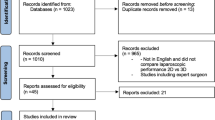Abstract
Background
Objective evidence is lacking as to the benefit of the addition of 3D vision to conventional laparoscopy in Gynecologic surgery. This study aims to compare 3-D visual system to traditional 2-D laparoscopic visualization for the laparoscopic closure of the vaginal cuff during total laparoscopic hysterectomy by surgeons-in-training [defined as senior OBGYN resident or Minimally Invasive Gynecologic Surgery (MIGS) fellow].
Methods
51 patients undergoing total laparoscopic hysterectomy at two tertiary care academic hospitals were randomized to two-dimensional or three-dimensional vision system with cuff closure performed by surgeons-in-training. The primary outcome was the time taken for vaginal cuff closure. Secondary outcomes included peri-operative outcomes and assessment of surgeon’s perception of ease of cuff closure.
Results
27 (52.9%) cases were allocated to cuff closure with the 2D system and 24 (47.1%) cases to closure with the 3D vision system. Patient baseline characteristics were similar between the vision systems. Mean vaginal cuff closure time was not significantly different between 2D and 3D vision (10.1 min for 2D versus 12 min for 3D, p = 0.31). An additional 24 s was added to cuff closure time with each 1 kg/m2 increase in BMI, after controlling for potential confounders (p = 0.003). There was no difference in the surgeon rating of ease of cuff closure between 2D and 3D. Peri-operative outcomes are similar among the two groups.
Conclusion
We did not demonstrate any benefits of 3D vision system over conventional 2D for the task of laparoscopic vaginal cuff suturing performed by surgeons-in-training.
RCT Registration Number NCT02192606 https://clinicaltrials.gov/ct2/show/NCT02192606 (July 17, 2014)


Similar content being viewed by others
References
Aarts JW, Nieboer TE, Johnson N, Tavender E, Garry R, Mol BW et al (2015) Surgical approach to hysterectomy for benign gynaecological disease. Cochrane Database Syst Rev 8:CD003677
Walsh CA, Walsh SR, Tang TY, Slack M (2009) Total abdominal hysterectomy versus total laparoscopic hysterectomy for benign disease: a meta-analysis. Eur J Obstet Gynecol Reprod Biol 144(1):3–7
Siedhoff MT, Wheeler SB, Rutstein SE, Geller EJ, Doll KM, Wu JM et al (2015) Laparoscopic hysterectomy with morcellation vs abdominal hysterectomy for presumed fibroid tumors in premenopausal women: a decision analysis. Am J Obstet Gynecol 212(5):591.e1–8
Fuchs Weizman N, Maurer R, Einarsson JI, Vitonis AF, Cohen SL (2015) Survey on barriers to adoption of laparoscopic surgery. J Surg Educ. 72(5):985–994
Rodrigues SP, Horeman T, Blomjous MS, Hiemstra E, van den Dobbelsteen JJ, Jansen FW (2016) Laparoscopic suturing learning curve in an open versus closed box trainer. Surg Endosc 30(1):315–322
Swenson CW, Kamdar NS, Harris JA, Uppal S, Campbell DA Jr, Morgan DM (2016) Comparison of robotic and other minimally invasive routes of hysterectomy for benign indications. Am J Obstet Gynecol 215(5):650.e1–e8
Rosero EB, Kho KA, Joshi GP, Giesecke M, Schaffer JI (2013) Comparison of robotic and laparoscopic hysterectomy for benign gynecologic disease. Obstet Gynecol 122(4):778–786
Wright JD, Ananth CV, Lewin SN, Burke WM, Lu YS, Neugut AI et al (2013) Robotically assisted vs laparoscopic hysterectomy among women with benign gynecologic disease. JAMA 309(7):689–698
Wright JD, Ananth CV, Tergas AI, Herzog TJ, Burke WM, Lewin SN et al (2014) An economic analysis of robotically assisted hysterectomy. Obstet Gynecol 123(5):1038–1048
Surgical I. Intuitive Surgical Investor Presentation Q3 2017.pdf. 2017
Kinoshita H, Nakagawa K, Usui Y, Iwamura M, Ito A, Miyajima A et al (2015) High-definition resolution three-dimensional imaging systems in laparoscopic radical prostatectomy: randomized comparative study with high-definition resolution two-dimensional systems. Surg Endosc 29(8):2203–2209
Lusch A, Bucur PL, Menhadji AD, Okhunov Z, Liss MA, Perez-Lanzac A et al (2014) Evaluation of the impact of three-dimensional vision on laparoscopic performance. J Endourol 28(2):261–266
Ozsoy M, Kallidonis P, Kyriazis I, Panagopoulos V, Vasilas M, Sakellaropoulos GC et al (2015) Novice surgeons: do they benefit from 3D laparoscopy? Lasers Med Sci 30(4):1325–1333
Smith R, Day A, Rockall T, Ballard K, Bailey M, Jourdan I (2012) Advanced stereoscopic projection technology significantly improves novice performance of minimally invasive surgical skills. Surg Endosc 26(6):1522–1527
Koppatz H, Harju J, Siren J, Mentula P, Scheinin T, Sallinen V (2019) Three-dimensional versus two-dimensional high-definition laparoscopy in cholecystectomy: a prospective randomized controlled study. Surg Endosc. https://doi.org/10.1007/s00464-019-06666-5
Usta TA, Karacan T, Naki MM, Calik A, Turkgeldi L, Kasimogullari V (2014) Comparison of 3-dimensional versus 2-dimensional laparoscopic vision system in total laparoscopic hysterectomy: a retrospective study. Arch Gynecol Obstet 290(4):705–709
Usta TA, Ozkaynak A, Kovalak E, Ergul E, Naki MM, Kaya E (2015) An assessment of the new generation three-dimensional high definition laparoscopic vision system on surgical skills: a randomized prospective study. Surg Endosc 29(8):2305–2313
Ko JK, Li RH, Cheung VY (2015) Two-dimensional versus three-dimensional laparoscopy: evaluation of physicians’ performance and preference using a pelvic trainer. J Minim Invasive Gynecol. 22(3):421–427
Herron DM, Lantis JC 2nd, Maykel J, Basu C, Schwaitzberg SD (1999) The 3-D monitor and head-mounted display. A quantitative evaluation of advanced laparoscopic viewing technologies. Surg Endosc 13(8):751–755
Einarsson JI, Cohen SL, Gobern JM, Sandberg EM, Hill-Lydecker CI, Wang K et al (2013) Barbed versus standard suture: a randomized trial for laparoscopic vaginal cuff closure. J Minim Invasive Gynecol. 20(4):492–498
Wright KN, Jonsdottir GM, Jorgensen S, Shah N, Einarsson JI (2012) Costs and outcomes of abdominal, vaginal, laparoscopic and robotic hysterectomies. JSLS. 16(4):519–524
Funding
The 3D equipment used at Brigham and Women’s Hospital was provided by Karl Storz (Tuttlingen, Germany).
Author information
Authors and Affiliations
Corresponding author
Ethics declarations
Disclosures
Drs. Mobolaji O. Ajao, Christian R. Larsen, Elmira Manoucheri, Maja T. Rask, Sarah L. Cohen, Martin Rudnicki, Jon I. Einarsson and Ms. Emily R. Goggins, Mary K. B. Cox, Avery Mushinski, and Xiangmei Gu have no conflicts of interest or financial ties to disclose.
Additional information
Publisher's Note
Springer Nature remains neutral with regard to jurisdictional claims in published maps and institutional affiliations.
Electronic supplementary material
Below is the link to the electronic supplementary material.
Rights and permissions
About this article
Cite this article
Ajao, M.O., Larsen, C.R., Manoucheri, E. et al. Two-dimensional (2D) versus three-dimensional (3D) laparoscopy for vaginal cuff closure by surgeons-in-training: a randomized controlled trial. Surg Endosc 34, 1237–1243 (2020). https://doi.org/10.1007/s00464-019-06886-9
Received:
Accepted:
Published:
Issue Date:
DOI: https://doi.org/10.1007/s00464-019-06886-9




